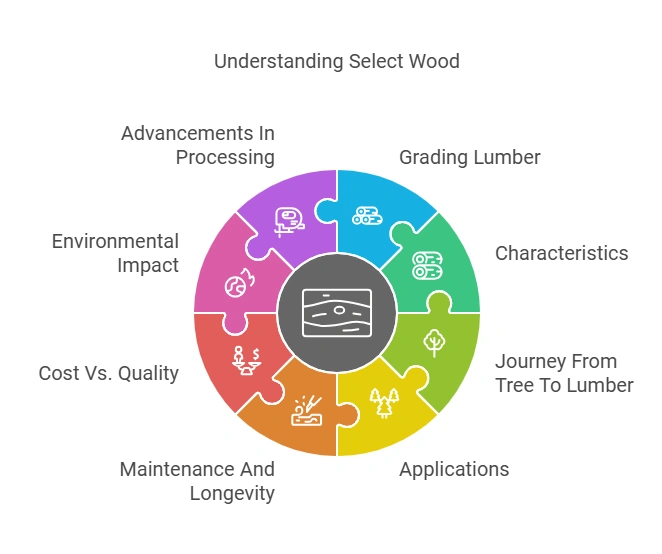Select wood refers to high-quality timber chosen for its durability and aesthetic appeal. It often comes from specific tree species known for their strength and beauty.
Select wood is a premium choice for furniture and construction. Known for its superior grain patterns and finish, it enhances the overall look of any project. Many homeowners and builders prefer select wood for its reliability and longevity. This type of wood is carefully harvested, ensuring that only the best pieces make it to market.
It can be found in various applications, including cabinetry, flooring, and decorative elements. Choosing select wood not only elevates design but also adds value to spaces. Its natural beauty and resilience make it a favored option for both residential and commercial projects.
Introduction To Select Wood
Select wood is known for its high quality and durability. It is used in many projects. This type of wood comes from carefully chosen trees. Each piece shows great craftsmanship.
The essence of quality lumber lies in its strength and beauty. Select wood is free from defects. This makes it ideal for fine furniture and structures. Builders and craftsmen prefer it for special projects.
In construction, select wood offers excellent support. It withstands heavy loads and lasts a long time. Many artisans use it for creating detailed designs. Select wood enhances the overall look of any project.

Grading Lumber: The Basics
Grading lumber is important for quality and value. Hardwood and softwood grades differ significantly. Hardwood comes from trees with broad leaves. Common hardwoods include oak, maple, and cherry. Softwood comes from trees with needles and cones. Examples of softwoods are pine, cedar, and spruce.
Each type has its own grading system. Hardwoods are graded based on appearance and defects. Softwoods are typically graded by strength and size. Understanding these grades helps buyers choose the right wood for their projects.
| Type | Examples | Grading Focus |
|---|---|---|
| Hardwood | Oak, Maple | Appearance, Defects |
| Softwood | Pine, Cedar | Strength, Size |
Several industry standards exist for grading lumber. The American Lumber Standard and the National Hardwood Lumber Association provide guidelines. These agencies ensure consistency and quality in lumber production.
Characteristics Of Select Wood
Select wood is known for its unique grain patterns and smooth texture. The wood often features beautiful swirls and lines. These patterns make each piece distinctive and appealing.
Color consistency is another important feature. Select wood usually has a uniform color throughout. This gives furniture and flooring a polished look. The appearance is often rich and warm, enhancing any space.
Overall, select wood is prized for its beauty and strength. It is a popular choice for many woodworking projects.
The Journey From Tree To Select Lumber
Select wood</strong is made from carefully chosen trees. Sustainable harvesting protects forests. This practice ensures trees are cut down responsibly.
The milling process is important for quality. Logs are cut into lumber with precision. This helps maintain the wood’s strength and beauty.
Quality control checks for defects. Each piece of wood is inspected closely. Only the best wood becomes select lumber.
| Aspect | Description |
|---|---|
| Sustainable Harvesting | Responsible cutting of trees to protect forests. |
| Milling Process | Precision cutting to maintain wood quality. |
| Quality Control | Inspection of wood for defects before selection. |
Applications Of Select Wood
Select wood is popular for many reasons. It is strong and beautiful. This type of wood is great for furniture making and cabinetry.
Many people choose select wood for high-quality furniture. It can last a long time. It also adds charm to any room.
In cabinetry, select wood provides a sleek and polished look. It is often used in kitchens and bathrooms. The wood can be stained or painted easily.
Architectural woodwork and detailing also benefit from select wood. Builders use it for trim, moldings, and doors. This wood enhances the style of homes and buildings.
Select wood is always a top choice for quality projects. It makes spaces feel warm and inviting.
Maintenance And Longevity
Select wood needs careful care to keep its beauty. Clean it regularly with a soft cloth. Avoid using harsh chemicals that can damage the surface. Moisture is a big enemy; keep wood dry and away from water. Use coasters and mats to protect it.
For scratches, use a wood filler that matches the color. Sand lightly and apply a finish for a smooth look. Regular polishing helps maintain its shine and protects from wear. Always check for signs of damage and repair promptly.
| Care Tips | Frequency |
|---|---|
| Dusting | Weekly |
| Polishing | Monthly |
| Inspection | Every 3 months |
Cost Vs. Quality: The Trade-offs
Choosing between premium lumber and lower grades is important. Select wood offers a great balance of cost and quality. Premium options are often more durable and attractive. They enhance the look of your space.
Investing in high-quality wood saves money in the long run. Less maintenance is needed, and repairs are rare. Lower grades can be cheaper upfront but may require more upkeep. This could lead to higher costs over time.
Consider your project needs carefully. Select wood provides better performance and aesthetic appeal. It is ideal for furniture, cabinetry, and flooring. Weigh the benefits of quality against the initial price to make the best choice.
Environmental Impact And Responsibility
Understanding the environmental impact of wood is important. Sustainable lumber helps protect forests. Certifications ensure that wood products come from responsible sources.
| Certification | Description |
|---|---|
| FSC | Forest Stewardship Council promotes responsible forest management. |
| PEFC | Programme for the Endorsement of Forest Certification supports sustainable forest practices. |
Consumers play a key role in responsible wood use. Choosing certified products encourages sustainable practices. Supporting eco-friendly companies helps protect the environment.

Advancements In Wood Processing
Advancements in wood processing have led to new innovations in lumber technology. These changes improve wood quality and durability. New techniques include heat treatment and chemical processes. These methods enhance resistance to pests and moisture.
By using advanced machinery, manufacturers can create more uniform wood products. This results in better performance and aesthetic appeal. Sustainable practices are also gaining traction. Eco-friendly methods reduce waste and promote renewable resources.
Overall, these innovations lead to stronger and longer-lasting wood products. The future of wood processing looks bright with continued advancements.
Finding And Purchasing Select Wood
Finding the right select wood is essential for quality projects. Start by searching for trusted suppliers and retailers. Look for businesses with positive reviews and a good reputation. Ask for recommendations from friends or online communities.
Inspect wood pieces closely. Check for knots, cracks, and warping. Choose pieces with a consistent grain and color. Avoid any wood that shows signs of damage or decay. Feel the texture; it should be smooth and clean.
Compare prices from different vendors. Quality select wood may cost more, but it is worth it. Investing in the best materials leads to better results in your projects.
Frequently Asked Questions
What Is Select Wood Used For?
Select Wood is primarily used in high-quality furniture and cabinetry. It offers durability and aesthetic appeal. This wood type is also popular for flooring and millwork. Its fine grain and consistent color make it an excellent choice for various interior applications.
How Is Select Wood Different From Regular Wood?
Select Wood is graded based on its quality and appearance. It has fewer knots and defects compared to regular wood. This grading ensures a more uniform look and superior finish. As a result, Select Wood is often more expensive but provides better performance and longevity.
What Types Of Trees Produce Select Wood?
Select Wood typically comes from hardwood trees like oak, maple, and cherry. Each type offers unique characteristics and finishes. These hardwoods are known for their strength and beauty. The sourcing of Select Wood often emphasizes sustainability and responsible forestry practices.
Is Select Wood Eco-friendly?
Yes, Select Wood can be eco-friendly when sourced responsibly. Many suppliers adhere to sustainable forestry practices. This includes replanting trees and maintaining biodiversity. Always look for certifications like FSC to ensure the wood is harvested ethically.
Conclusion
Select wood is a versatile choice for various projects. Its quality and aesthetic appeal make it ideal for furniture, flooring, and cabinetry. Understanding its features helps in making informed decisions. By choosing select wood, you invest in durability and beauty that enhance any space.
Explore its benefits for your next project.

